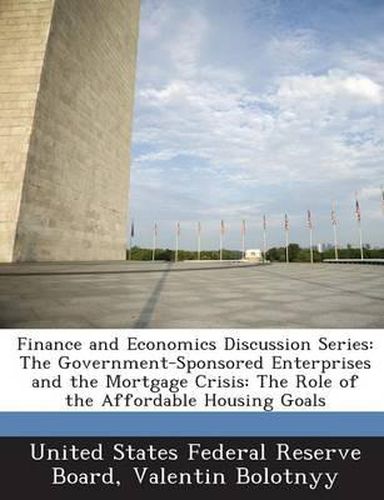Readings Newsletter
Become a Readings Member to make your shopping experience even easier.
Sign in or sign up for free!
You’re not far away from qualifying for FREE standard shipping within Australia
You’ve qualified for FREE standard shipping within Australia
The cart is loading…






The U.S. mortgage crisis that began in 2007 generated questions about the role played by Fannie Mae and Freddie Mac, the Government-Sponsored Enterprises (GSEs), in its causes. Some have claimed that the Affordable Housing Goals (AHGs), introduced by Congress through the GSE Act of 1992, and the resulting purchases of single-family mortgages the GSEs made to meet those goals, drove lending to high-risk borrowers. Using regression discontinuity analysis, I measure the effect of one of the goals, the Underserved Areas Goal (UAG), on the number of whole single-family mortgages purchased by the GSEs in targeted census tracts from 1996 to 2002. Focusing additionally on tracts that became UAG-eligible in 2005-2006, when the Department of Housing and Urban Development (HUD) began to determine eligibility using the 2000 Census, I measure the effect of the UAG on the GSEs’ whole single-family mortgage purchases during peak years for the subprime mortgage market. Under the first approach, I estimate that the GSEs purchased 0 to 3 percent more goal-eligible mortgages than they would have without the UAG in place. Under the second approach, I estimate this effect to be 2.5 to 5 percent. The results suggest a small UAG effect and challenge the view that the goals caused the GSEs to supply substantially more credit to high-risk borrowers than they otherwise would have supplied. Although the goals may have spurred the GSEs to purchase more multi-family mortgages and REMICs than they otherwise would have, my analyses suggest that the GSEs’ purchases of whole single-family mortgages to satisfy the goals did not drive the subprime lending boom of 2002-2006.
$9.00 standard shipping within Australia
FREE standard shipping within Australia for orders over $100.00
Express & International shipping calculated at checkout
The U.S. mortgage crisis that began in 2007 generated questions about the role played by Fannie Mae and Freddie Mac, the Government-Sponsored Enterprises (GSEs), in its causes. Some have claimed that the Affordable Housing Goals (AHGs), introduced by Congress through the GSE Act of 1992, and the resulting purchases of single-family mortgages the GSEs made to meet those goals, drove lending to high-risk borrowers. Using regression discontinuity analysis, I measure the effect of one of the goals, the Underserved Areas Goal (UAG), on the number of whole single-family mortgages purchased by the GSEs in targeted census tracts from 1996 to 2002. Focusing additionally on tracts that became UAG-eligible in 2005-2006, when the Department of Housing and Urban Development (HUD) began to determine eligibility using the 2000 Census, I measure the effect of the UAG on the GSEs’ whole single-family mortgage purchases during peak years for the subprime mortgage market. Under the first approach, I estimate that the GSEs purchased 0 to 3 percent more goal-eligible mortgages than they would have without the UAG in place. Under the second approach, I estimate this effect to be 2.5 to 5 percent. The results suggest a small UAG effect and challenge the view that the goals caused the GSEs to supply substantially more credit to high-risk borrowers than they otherwise would have supplied. Although the goals may have spurred the GSEs to purchase more multi-family mortgages and REMICs than they otherwise would have, my analyses suggest that the GSEs’ purchases of whole single-family mortgages to satisfy the goals did not drive the subprime lending boom of 2002-2006.